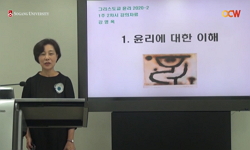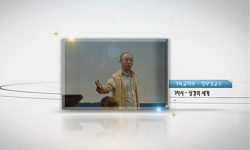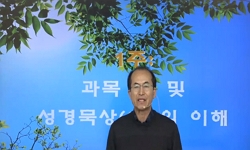본 논문은 괴테의 『파우스트 I』에서 <밤>장면의 부활절 합창의 기능과 부활절의 의미, 그리고 <성문 앞> 부활절 축제일을 맞이하는 사람들의 태도와 관심사를 분석해 봄으로써, 괴...
http://chineseinput.net/에서 pinyin(병음)방식으로 중국어를 변환할 수 있습니다.
변환된 중국어를 복사하여 사용하시면 됩니다.
- 中文 을 입력하시려면 zhongwen을 입력하시고 space를누르시면됩니다.
- 北京 을 입력하시려면 beijing을 입력하시고 space를 누르시면 됩니다.

괴테 『파우스트 I』의 부활절 장면과 기독성 = The Easter Scene and Christian Spirit Portrayed in <Vor dem Tor> in Goethe's Faust
한글로보기https://www.riss.kr/link?id=A76513172
- 저자
- 발행기관
- 학술지명
- 권호사항
-
발행연도
2007
-
작성언어
-
- 주제어
-
KDC
800
-
등재정보
KCI등재
-
자료형태
학술저널
-
수록면
345-360(16쪽)
- 제공처
- 소장기관
-
0
상세조회 -
0
다운로드
부가정보
국문 초록 (Abstract)
부활절 합창의 내용은 부활의 기쁜 소식을 전하며 다시 사신 그리스도를 찬양하고 제자로서의 삶의 목표를 일깨워 준다는 점에서 신약 성서상의 부활 정신과 일치함을 알 수 있다. 이 노래는 삶을 포기하려는 파우스트에게 삶의 용기를 준다.
<성문 앞> 장면에서는 봄철 만물이 소생하는 자연 세계와 부활의 의미를 내포하는 초자연적 세계와의 연관성에 대해 분석하였다. 전 장면인 <밤> 과 비교할 때 어둠과 빛, 겨울과 봄, 죽음과 불멸, 육체와 정신, 구속과 자유의 의미로 대비되어 나타나며 성서적인 상징성을 지니고 있음을 알 수 있다.
부활절 주일을 즐기는 산보자들의 모습은 원래의 부활절 정신과는 매우 동떨어지게 나타나고 있다. 젊은이들의 관심은 이성에 집중되고 있으나 이들의 인간 관계는 개인적, 정신적인 사랑의 관계라기보다는 신체적, 성적인 면에 관심이 치우치고 있다. 시민들은 외국에서 일어나는 전쟁에 대해 대화하지만 실제적으로 자신들과 관계없는 일이라는 무관심한 태도이다.
<성문 앞> 마지막 장면에서 파우스트는 다시금 새와 같이 하늘로 비상하는 소원을 품게 되고 그러한 수단으로써 공중의 영을 갈망하게 된다. 이러한 그의 모습은 인간의 한계를 벗어나고 싶은 인간의 오만한 본성이 잘 나타난다. 부활절 해질 무렵 파우스트는 길에서 만난 검은 개에게서 마성을 감지한다. 그러나 이러한 특성에 둔감한 바그너의 권유로 그 개를 집으로 데려간다. 이로써 <천상의 서곡>에서 예견된 바와 같이 그가 메피스토펠레스에 의해 장차 유혹되리라는 예측을 낳게 하며, 그의 삶 속에 내재하는 악의 현존을 암시하게 된다.
이와 같이 괴테는 <성문 앞>장면에서 기독교 부활 사상을 반영하고 있다. 또한 에베소서 2장에서 바울이 경고하는 바와 같이 공중의 영을 좇아 사는 삶, 세상 풍속을 따르는 삶, 육체의 욕심에 이끌리는 인간 삶의 실상을 보여줌으로써 창조이래로부터 미지의 존재로써의 인간의 본질에 대한 문제를 제시하고 있다.
본 논문은 괴테의 『파우스트 I』에서 <밤>장면의 부활절 합창의 기능과 부활절의 의미, 그리고 <성문 앞> 부활절 축제일을 맞이하는 사람들의 태도와 관심사를 분석해 봄으로써, 괴테의 사상과 기독교적 특성과의 관계에 대해 고찰하였다. 이 장면에서 고전주의자 괴테의 사상적 특성이 잘 나타나는 이유는 그가 쓴 1790년 『파우스트 프라그멘트』에는 없는 장면이기 때문이다.
부활절 합창의 내용은 부활의 기쁜 소식을 전하며 다시 사신 그리스도를 찬양하고 제자로서의 삶의 목표를 일깨워 준다는 점에서 신약 성서상의 부활 정신과 일치함을 알 수 있다. 이 노래는 삶을 포기하려는 파우스트에게 삶의 용기를 준다.
<성문 앞> 장면에서는 봄철 만물이 소생하는 자연 세계와 부활의 의미를 내포하는 초자연적 세계와의 연관성에 대해 분석하였다. 전 장면인 <밤> 과 비교할 때 어둠과 빛, 겨울과 봄, 죽음과 불멸, 육체와 정신, 구속과 자유의 의미로 대비되어 나타나며 성서적인 상징성을 지니고 있음을 알 수 있다.
부활절 주일을 즐기는 산보자들의 모습은 원래의 부활절 정신과는 매우 동떨어지게 나타나고 있다. 젊은이들의 관심은 이성에 집중되고 있으나 이들의 인간 관계는 개인적, 정신적인 사랑의 관계라기보다는 신체적, 성적인 면에 관심이 치우치고 있다. 시민들은 외국에서 일어나는 전쟁에 대해 대화하지만 실제적으로 자신들과 관계없는 일이라는 무관심한 태도이다.
<성문 앞> 마지막 장면에서 파우스트는 다시금 새와 같이 하늘로 비상하는 소원을 품게 되고 그러한 수단으로써 공중의 영을 갈망하게 된다. 이러한 그의 모습은 인간의 한계를 벗어나고 싶은 인간의 오만한 본성이 잘 나타난다. 부활절 해질 무렵 파우스트는 길에서 만난 검은 개에게서 마성을 감지한다. 그러나 이러한 특성에 둔감한 바그너의 권유로 그 개를 집으로 데려간다. 이로써 <천상의 서곡>에서 예견된 바와 같이 그가 메피스토펠레스에 의해 장차 유혹되리라는 예측을 낳게 하며, 그의 삶 속에 내재하는 악의 현존을 암시하게 된다.
이와 같이 괴테는 <성문 앞>장면에서 기독교 부활 사상을 반영하고 있다. 또한 에베소서 2장에서 바울이 경고하는 바와 같이 공중의 영을 좇아 사는 삶, 세상 풍속을 따르는 삶, 육체의 욕심에 이끌리는 인간 삶의 실상을 보여줌으로써 창조이래로부터 미지의 존재로써의 인간의 본질에 대한 문제를 제시하고 있다.
다국어 초록 (Multilingual Abstract)
Faust, unlike Wagner, who lacks spiritual power, shows great sensitivity to the magic power of a black poodle he sees at the end of the festival day. Ignoring the evil power, Faust takes the "devil-dog" to his house and subsequently succumbs to the temptation of Mephistopheles. As already suggested in <Prolog im Himmel>, Faust will be tempted by Mephistopheles, who sees himself as a descendant of the serpent in the Garden of Eden. Accordingly, Goethe's views on religious matters in the said scenes of the Easter celebration coincide with the Biblical spirit in Ephesians 2: 1-5, which concerns existential questions that people today wrestle with.
This paper will study and analyze the content of the choristers' hymn of <Nacht> and the scene of Easter celebration, <Vor dem Tor>, which Goethe added later to his previous fragment 1790. The function of the Easter chorale coincides with ...
This paper will study and analyze the content of the choristers' hymn of <Nacht> and the scene of Easter celebration, <Vor dem Tor>, which Goethe added later to his previous fragment 1790. The function of the Easter chorale coincides with the contents of the Bible in its celebration of Christ reborn from death. In a word, Faust stops his attempt to commit suicide by listening to the chorale. He goes outside and meets various people who enjoy Easter Sunday. In addition to the positive aspects, the negative aspects of the religious feast day are also portrayed: the young men's physical and spontaneous sexual interest toward the opposite sex, and their not realizing the true meaning of the Easter celebration. Naturally, all the egoistic, earthly characteristics of the people, such as citizens, a beggar, and a fortuneteller, are presented. They appear to take advantage of the public holiday.
Faust, unlike Wagner, who lacks spiritual power, shows great sensitivity to the magic power of a black poodle he sees at the end of the festival day. Ignoring the evil power, Faust takes the "devil-dog" to his house and subsequently succumbs to the temptation of Mephistopheles. As already suggested in <Prolog im Himmel>, Faust will be tempted by Mephistopheles, who sees himself as a descendant of the serpent in the Garden of Eden. Accordingly, Goethe's views on religious matters in the said scenes of the Easter celebration coincide with the Biblical spirit in Ephesians 2: 1-5, which concerns existential questions that people today wrestle with.
목차 (Table of Contents)
- Ⅰ. 서론
- Ⅱ. 부활의 성서적 의미
- Ⅲ. 산보자들의 다양한 태도
- Ⅳ. 결론
- 참고 문헌
- Ⅰ. 서론
- Ⅱ. 부활의 성서적 의미
- Ⅲ. 산보자들의 다양한 태도
- Ⅳ. 결론
- 참고 문헌
- 초록
동일학술지(권/호) 다른 논문
-
- 한국외국어대학교 외국문학연구소
- 김태철(Kim, Tae-chul)
- 2007
- KCI등재
-
- 한국외국어대학교 외국문학연구소
- 이시준(Lee Si-jun)
- 2007
- KCI등재
-
- 한국외국어대학교 외국문학연구소
- 김욱동(Kim, Wook-dong)
- 2007
- KCI등재
-
- 한국외국어대학교 외국문학연구소
- 김운찬(Kim, Woon-chan)
- 2007
- KCI등재




 스콜라
스콜라







